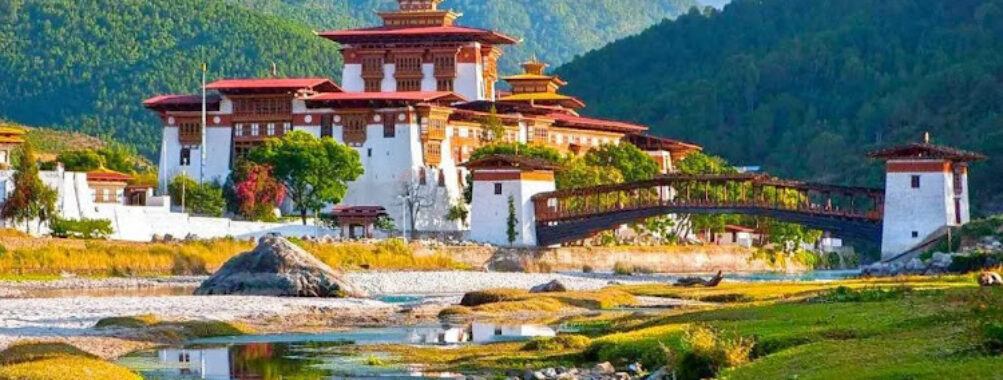
Bhutan Tour
“`html
Table of Contents
Description
Bhutan has this quiet, almost magical way of slowing you down. It’s not the kind of place you rush through with a checklist — it’s more like a slow exhale after years of holding your breath. The Bhutan Tour offers travelers a rare glimpse into a country that measures success not by wealth, but by happiness. And honestly, that’s something you start to feel the moment you arrive. The air feels cleaner, the smiles more genuine, and the mountains — well, they make you feel small in the best possible way.
Travelers often describe Bhutan as a place that still remembers what matters — community, spirituality, and harmony with nature. The tour takes you through ancient monasteries perched on cliffs, lush valleys dotted with prayer flags, and towns where monks chant in the early morning mist. It’s spiritual, yes, but also deeply human. You’ll find yourself laughing with locals over butter tea one minute and standing in reverent silence before a centuries-old temple the next.
What stands out most is the authenticity. There’s no pretense here. The guides don’t just recite facts; they share stories — about their families, the festivals they grew up with, the legends that shaped their villages. It’s like being welcomed into a living, breathing storybook. And maybe that’s why so many travelers leave Bhutan feeling changed — not in a dramatic, life-altering way, but in a quiet, lingering one.
Key Features
- Cultural Immersion: Experience Bhutan’s living traditions through local festivals, crafts, and cuisine that reflect centuries of heritage.
- Spiritual Exploration: Visit sacred monasteries like Paro Taktsang (Tiger’s Nest) and Punakha Dzong, where history and faith intertwine.
- Scenic Landscapes: From snow-capped peaks to emerald valleys, the country’s natural beauty feels almost untouched.
- Guided Local Insights: Knowledgeable guides share personal stories and cultural nuances that go beyond guidebooks.
- Eco-Friendly Travel: Bhutan’s commitment to sustainability ensures that tourism supports both nature and community life.
- Personalized Itineraries: Tours can be tailored for hikers, photographers, or cultural enthusiasts seeking meaningful experiences.
What I love most is how the tour balances adventure with introspection. One day you’re trekking through forests where rhododendrons bloom like fireworks, and the next you’re sitting cross-legged in a monastery listening to monks chant. It’s not about ticking off sights — it’s about feeling them.
Best Time to Visit
If you ask me, spring (March to May) is the sweet spot. The valleys burst into color with wildflowers, and the skies are usually clear enough to see the Himalayas in full glory. Autumn (September to November) is another favorite — crisp air, golden fields, and those picture-perfect festival days that make you feel like you’ve stepped into a postcard.
Winter can be chilly, especially in the higher regions, but it has its own charm. Fewer tourists, peaceful monasteries, and a kind of stillness that’s hard to find elsewhere. Summer, on the other hand, brings lush greenery and dramatic clouds rolling over the mountains — though you’ll need to be okay with a bit of rain.
Honestly, there’s no bad time to visit Bhutan. It just depends on what you’re after — color and celebration, or solitude and serenity.
How to Get There
Getting to Bhutan feels like a small adventure in itself. The country’s only international airport is in Paro, and the flight there is one you’ll never forget — weaving between Himalayan peaks before landing in a narrow valley that makes your heart skip a beat (in the best way). Airlines like Druk Air and Bhutan Airlines operate flights from cities such as Bangkok, Kathmandu, Delhi, and Singapore.
If you’re more of a road-trip person, you can also enter Bhutan via land through Phuentsholing, Gelephu, or Samdrup Jongkhar from India. The drive offers a fascinating transition — one moment you’re in the hustle of Indian border towns, and the next, you’re surrounded by calm mountain air and fluttering prayer flags.
Most travelers book their Bhutan Tour through licensed operators (it’s actually required), which simplifies everything — from visas to transport and accommodation. Trust me, it’s worth it. The guides handle the details so you can focus on soaking in the experience.
Tips for Visiting
A few things I wish I’d known before my first Bhutan trip:
- Respect Local Customs: Bhutanese culture is deeply spiritual. Dress modestly, remove your shoes before entering temples, and always ask before taking photos of monks or religious sites.
- Pack Smart: Layers are your best friend. The weather can change faster than you expect — warm sun one minute, chilly wind the next.
- Stay Curious: Don’t just stick to the itinerary. Chat with locals, try ema datshi (the famous chili cheese), and join in a dance if you’re invited during a festival.
- Disconnect to Reconnect: Wi-Fi can be spotty, but that’s part of the charm. Take it as an invitation to be fully present — no screens, just mountains, monasteries, and moments that stick with you.
- Bring Cash: While some places accept cards, smaller shops and rural areas often prefer cash in Bhutanese Ngultrum.
- Travel Lightly: Bhutan takes sustainability seriously. Avoid plastic bottles and carry a refillable one instead.
And here’s a personal tip — take time to just sit somewhere quiet. Maybe on a hillside overlooking a valley or beside a prayer wheel turning in the breeze. Let the sound of chanting drift over you, and notice how still everything feels. That’s Bhutan’s real magic — it reminds you to slow down, breathe, and just be.
Every traveler I’ve met who’s been to Bhutan says the same thing: it’s not just a trip, it’s a feeling. And long after you’ve left, that feeling — of peace, of wonder, of connection — stays with you.
“`
Location
Places to Stay Near Bhutan Tour
Find and Book a Tour
Explore More Travel Guides
No reviews found! Be the first to review!